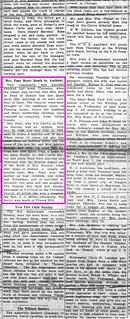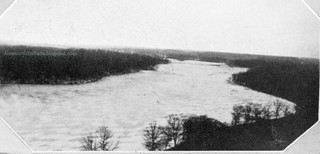In the wee hours of the morning on Thursday, July 21, 1921, a car carrying two men and two women was speeding north on Broadway in Gary when it slammed into a parked car. The impact sent the woman in the front seat flying through the windshield. Unconscious and critically injured, she was rushed to a hospital. Oddly, no one seemed know her name, only that she lived somewhere "between Hobart and Ainsworth" — or, at any rate, that was the sketchy report that reached the offices of the
Hobart News around noon that day. With the paper about to go to press, the staff scrambled to confirm the report and get more information. They failed. The paper came out with no mention of the accident.
The woman died soon after reaching the hospital, without ever regaining consciousness. Her body was taken to the Gary morgue. Gary authorities, having somehow reached a tentative identification, got in touch with a Hobart resident, Jesse Peas, who had just finished a day's work with the EJ&E railroad, and asked him to come to the Gary morgue. He did. There he identified the dead woman as his 31-year-old wife, Carrie.
The next week's Hobart papers printed Carrie's obituary. Hers was a touching story.
 (Click on image to enlarge)
(Click on image to enlarge)
As a child, Carrie had been placed in the
Julia E. Work Training School in Marshall County, Indiana; and Jesse* in the Rush County Poor Asylum & Orphans Home. Sometime after 1900, Adolph and Augusta Mueller took these two children into their home. The Muellers' only natural child, Bertha, had married
Ben Bodamer in 1898, so perhaps they were feeling lonely, and they probably needed help around the farm.
The only census showing the Muellers and Peases together (1910) describes Jesse as a "handman" and Carrie as a "servant." By then Jesse and Carrie had a three-year-old boy, Albert, and had lost one child. This joint household farmed rented land in Winfield Township. Apparently these folks moved around a bit. In 1907 the Adolph Muellers lived on "the Ainsworth-Deepriver road" (probably E. 73rd Ave.). In October 1908 the
Gazette reported that "Mr. and Mrs. Jesse Peas who formerly lived west of Deepriver have moved upon a farm near Hebron" — suggesting that the two little families separated for a time.
Adolph Mueller died in May 1914; Augusta in December of that year, at which time her home had been with Jesse and Carrie somewhere south of Ainsworth, "near Deer Creek." In February 1915, Jesse and Carrie moved to Hobart, to "the Dr. Friedrich house on Lillian street." A year and a half later, they had moved to Ainsworth, where Jesse was "working on the railroad" — the Grand Trunk, presumably. The following spring they moved back to Hobart, to "the Gordon house on Lake street." They remained in Hobart, as far as I can tell. Jesse got work in a Gary steel mill for several years before joining the EJ&E railroad.
I'd like to think that this was a story of two orphans, adopted by kindly old folks, finding true love and happiness together for a few precious years. The only thing that puzzles me — and no newspaper had a word of explanation — was why Carrie was running around in Gary at 1:30 a.m. with some man who was not her husband. The driver of the car was George Akers of Gary. Their other companions were Rush Harmon of Gary and Mrs. Myrtle Seeps of Indiana Harbor. Who
were these people?
Well, all I can say is that if Carrie had not been behaving exactly as she ought to, I can see plenty in her background that might push a person toward instability: her being orphaned by the age of 9, and becoming a wife and mother by the age of 16; the frequent moves of her household and Jesse's job changes; the loss of a child early on in the marriage, and then the death of her three-year-old daughter from diphtheria in
November 1920.
Within a week of the accident, Jesse filed an affidavit against this mysterious George Akers, charging him with manslaughter, alleging that he "did drive a car at a high and unlawful rate of speed and thereby [cause] the death of Mrs. Carrie Pease."
We may learn more from this case.
For now, I'm not sure what Jesse's future holds. I can't find him in the 1930 census. By 1940, he may have remarried and moved back to Rushville.
If Carrie's final resting place remains Crown Hill Cemetery, her grave is unmarked.
______________________________________
*Jesse's surname turns up spelled various ways over the years, including "Pea," "Peas" and "Pease."
Sources:
♦ 1900 Census.
♦ 1910 Census.
♦ 1920 Census.
♦ 1930 Census.
♦ 1940 Census.
♦ "Additional Local News." Hobart Gazette 16 June 1916.
♦ Ancestry.com. Lake County, Indiana Index to Birth Records, 1882-1920 [database on-line]. Provo, UT, USA: Ancestry.com Operations Inc, 2002. Original data: Indiana Works Progress Administration, comp. Index to birth records, Lake County, Indiana, 1882-1920. Crown Point, IN, USA: The Administration, 1938.
♦ "Death of Mrs. Mueller." Hobart Gazette 18 Dec. 1914.
♦ "Funeral of Mrs. Jesse Pease Held at Christian Church Sunday P.M." Hobart News 28 July 1921.
♦ "General News Items." Hobart Gazette 31 May 1907.
♦ "Identity of Mrs. Pease Not Known Until Thursday Afternoon." Hobart News 28 July 1921.
♦ Indiana WPA Death Records Index.
♦ "Local Drifts." Hobart Gazette 16 Oct. 1908; 19 Feb. 1915; 16 Mar. 1917.
♦ "Mrs. Peas Meets Death by Accident." Hobart Gazette 29 July 1921.


















































